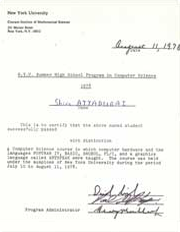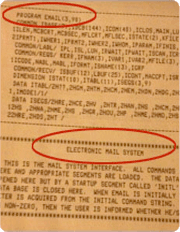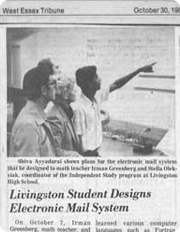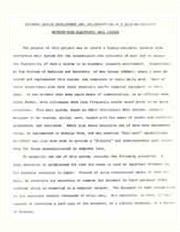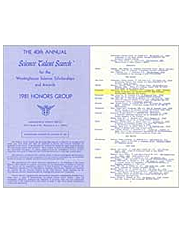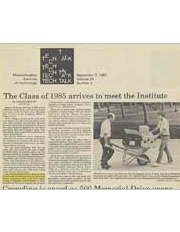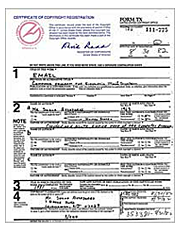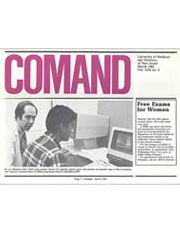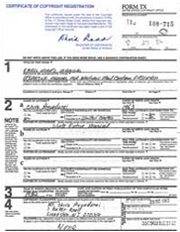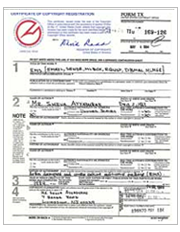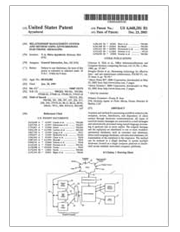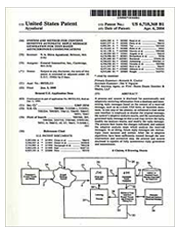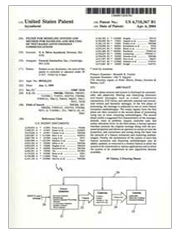August 30, 2011 marks the 29th Anniversary of EMAIL, marked by the formal issuance of the copyright for "EMAIL" by the US Copyright Office. Earlier, starting in 1978, I began creating the first email system, the “electronified” version of the emulation of the full-scale interoffice paper mail system, while 14-years old, at the University of Medicine and Dentistry of New Jersey (UMDNJ). In fact the term "EMAIL" itself was a new term. The two words, "Electronic" and "Mail" juxtaposed together for me originally brought images of vaporizing paper and somehow transporting it across electrical wires, like the transporter in Star Trek. That is how NEW those two terms next to each other were in 1978.
Inventing EMAIL - The History of EMAIL
By V. A. SHIVA

So Electronic MAIL, literally meant the Electronic version of MAIL. What was MAIL in 1978? MAIL meant interoffice communications. Such a communication was called a "letter" or "memorandum" or "inter- intra-office mail". A typical MAIL had the title of MEMORANDUM, with "To:", "From:", "Date:", "Subject:", "Cc:", "Bcc:", "Attachment", elements. This was the meaning of MAIL. As a high school student, Les Michelson, the Director of the Computer Laboratory at UMDNJ challenged me to create an "Electronic MAIL" system, one that would convert the paper transmittal of MEMOS with an electronic equivalent for UMDNJ.
I began by studying how interoffice mail was created, its characteristics, how it moved within one building, within a campus and across the three campuses of UMDNJ: Newark, Piscataway and New Brunswick (all in New Jersey). It was fascinating. Cc literally meant carbon copy. A secretary would put a piece of carbon paper between two sheets of white letter and type to create a carbon copy, one which was sent to the original recipient and the other to the person Cc'd. Such an analysis and understanding was new in 1978. I spent the next three years building the first Electronic MAIL system. I was asked to apply for the Westinghouse Science Award for which I was recognized with an Honors Award in 1981for its innovation. At that time, I had no idea of its impact. I remember in the MIT Tech Talk, however, that MIT had singled out three incoming class members' prior work, and the EMAIL system was referenced in that article.
In 1981, for some reason, I applied for a US Copyright. No one compelled me to. I thought about it as a literally piece of work, and thought it should be properly referenced. It took over one year to explain to the Copyright office what email was, finally resulting in the Copyright being issued in August 30, 1982 for EMAIL.
There is a pre-email history, with its early innovators. Their contributions were not minimal, but important precursors to email. Such innovators included Tom Van Vleck in 1961, who very few people know, was the first one to send an electronic text message within a single computer from one user to another user. Leonard Kleinrock, in 1969, then demonstrated the sending of an electronic messages across two (2) computers. Ray Tomlinson in 1971, then combined two pre-existing tools, SNDMSG and CPYNET, to send an electronic message using the @ symbol across multiple computers. The developments of protocols such as TCP/IP and RFC, made it possible to provide the underpinnings for transmitting text messages across the Internet.
However, email is not just electronic TXT messages. Email, as stated above, had a very specific meaning. It had all those important fields, which today we take for granted. To build EMAIL that an office worker at UMDNJ could use, one had to create a REAL System. Prior to that, only scientists and technical programmers could send electronic messages. Such a System needed a database, a high-level programming language, redundancy to ensure reliability, an easy-to-use interface, and much more. That EMAIL System is what I had the pleasure of building during 1978-1981.
The confusion of email and TEXT Messaging, which exists even today in 2011, has caused even experts to think that email will be replaced by electronic messaging. e.g. IM will replace email, text chat will replace email. Since 2000, experts at Gartner, PC Week, and others have made these claims. Even now, in 2011, experts, Zuckerburg, etc. claim, email will be replaced. The data shows otherwise. Email volume continues to grow. Email access on web, and now mobile devices, is growing exponentially. YES, many people text and chat, BUT that is not email, just like what Van Vleck and others did is not email. Email is a bit more structured, formal, again the "To:", "From:", "Cc:", etc. fields, originating from office mail, make this difference.
Ironically, even as Zuckerburg declares as some trade journals said, "EMAIL IS DEAD", he is launching @Facebook as a direct challenge to GMail. He says it will have email in it, along with other types of "messaging."
I began by studying how interoffice mail was created, its characteristics, how it moved within one building, within a campus and across the three campuses of UMDNJ: Newark, Piscataway and New Brunswick (all in New Jersey). It was fascinating. Cc literally meant carbon copy. A secretary would put a piece of carbon paper between two sheets of white letter and type to create a carbon copy, one which was sent to the original recipient and the other to the person Cc'd. Such an analysis and understanding was new in 1978. I spent the next three years building the first Electronic MAIL system. I was asked to apply for the Westinghouse Science Award for which I was recognized with an Honors Award in 1981for its innovation. At that time, I had no idea of its impact. I remember in the MIT Tech Talk, however, that MIT had singled out three incoming class members' prior work, and the EMAIL system was referenced in that article.
In 1981, for some reason, I applied for a US Copyright. No one compelled me to. I thought about it as a literally piece of work, and thought it should be properly referenced. It took over one year to explain to the Copyright office what email was, finally resulting in the Copyright being issued in August 30, 1982 for EMAIL.
There is a pre-email history, with its early innovators. Their contributions were not minimal, but important precursors to email. Such innovators included Tom Van Vleck in 1961, who very few people know, was the first one to send an electronic text message within a single computer from one user to another user. Leonard Kleinrock, in 1969, then demonstrated the sending of an electronic messages across two (2) computers. Ray Tomlinson in 1971, then combined two pre-existing tools, SNDMSG and CPYNET, to send an electronic message using the @ symbol across multiple computers. The developments of protocols such as TCP/IP and RFC, made it possible to provide the underpinnings for transmitting text messages across the Internet.
However, email is not just electronic TXT messages. Email, as stated above, had a very specific meaning. It had all those important fields, which today we take for granted. To build EMAIL that an office worker at UMDNJ could use, one had to create a REAL System. Prior to that, only scientists and technical programmers could send electronic messages. Such a System needed a database, a high-level programming language, redundancy to ensure reliability, an easy-to-use interface, and much more. That EMAIL System is what I had the pleasure of building during 1978-1981.
The confusion of email and TEXT Messaging, which exists even today in 2011, has caused even experts to think that email will be replaced by electronic messaging. e.g. IM will replace email, text chat will replace email. Since 2000, experts at Gartner, PC Week, and others have made these claims. Even now, in 2011, experts, Zuckerburg, etc. claim, email will be replaced. The data shows otherwise. Email volume continues to grow. Email access on web, and now mobile devices, is growing exponentially. YES, many people text and chat, BUT that is not email, just like what Van Vleck and others did is not email. Email is a bit more structured, formal, again the "To:", "From:", "Cc:", etc. fields, originating from office mail, make this difference.
Ironically, even as Zuckerburg declares as some trade journals said, "EMAIL IS DEAD", he is launching @Facebook as a direct challenge to GMail. He says it will have email in it, along with other types of "messaging."
History of EMAIL
Contents
Dr. V. A. Shiva Ayyadurai, an MIT alumni who holds two teaching appointments at MIT, developed the first Email System, which is a system of interlocked parts emulating the full-scale interoffice paper mail system, in 1978. Many important and noted individuals contributed to various Components of an Email System, such as electronic messaging protocols, programming languages, database systems and networking protocols. These early developments resulted in enabling the transaction of electronic messages using cryptic codes, only usable and understandable by computer engineers, nerdy students and scientists. No Email System (with Inbox, Outbox, editor, etc.), however, existed with easy-to-use interface console, network-wide with a rich set of features, until, 1978, when Dr. V. A. Shiva Ayyadurai, then a precocious 14 year-old, invented the first Email System, to enable medical doctors distributed network wide, across three locations in New Jersey, to send and receive email. The development of such a real Email System was motivated largely because of the user base: medical doctors. Medical doctors, then and now, were/are perhaps the most unlikely to use and adopt computers.
First, this is an important question. The answer to which we take for granted, that billions of us use Email Systems such as Gmail, Yahoo and others. An Email System, a system of interlocked parts emulating the full-scale interoffice paper mail system, is characterized by the following attributes:
- Easy-to-Use (e.g. no need for cryptic codes that only a Geek can use)
- Rich set of features (e.g. Inbox, Outbox, Folders, Editor, Return Receipt)
- Network Wide (e.g. multiple servers, multiple users, multiple locations)
- Security Protocols (e.g. login with username and password )
- Enterprise Management (e.g. administrator control, cleanup, EMAIL management)
- Database and Archival (e.g. relational data structures to store messages, retrieve, sort, etc.)
In writing this History, I was amazed at the vision that Dr. V. A. Shiva Ayyadurai had, even as a 14 year old, in developing that first Email System. In reading the manual and reviewing his code, which he was gracious to make available to me, I noticed the following features of email that he developed starting in 1978:
- User-Friendly Interface. He had built a very easy-to-use friendly interface that even a grandma could use. And, remember, this was developed at a time when the screen only supported 80 characters across the screen and 20 characters vertically. The Menu had the concept of Inbox, and Outbox allowed the user to Create a Message, Receive Email, on-line Help, Broadcast Messages (early Email Marketing), and the ability to contact the System Administrator
- A Rich Set of Features. The System offered the ability to sort and view the Inbox and Outbox, to create Folders, even the ability to send Registered Mail! The System provided an editor, the ability to save a Draft, Send and Receive Messages. It also offered settings for Retries if there were Network Issues. Messages could also be archived, stored and deleted. I could not find any features that we have today, except for the mouse and graphical user interface that was missing in this first Email System.
- Network Wide. The System enabled users to be resident across three geographical locations, each of which had three different servers (nodes) and multiple users at each location, with their own computers, connected to the servers. Various checks and balances were put into this first Email System for ensuring transaction of messages across locations e.g. if one server went down, what to do, when to resend, etc. Administrative tools and reports for managing network message transactions were part and parcel of email.
- Security and Login. This system assigned each person a Username and Password. Most importantly, one could be at different locations and get their email. Each of the different locations had access to the Master User and Password tables, so users could seamlessly move to different locations and access their email, something, which we take for, granted today.
- Enterprise Email Management. Once such a system was built, many other administrative features were added, such as what to do if a person forgot their username and password, archival and retention policies, limits on how long an email message would be stored, when to clean up the system, etc. These were not always evident to the user, but on the back end of most systems such issues need to be addressed.
- Database and Archival. Any system is not a System without storage. This first Email System incorporated emerging database technology in a relational data store to index messages, users, and sort and rapidly transact messages. The incorporation of such a sophisticated database structure provided the ability for this first Email System to offer many of the Rich Features described above.
There are two parts to this history I've organized. The first part is the history of the development of the various Components of Email. This first part is based on extant history, which many of you may have read in Googling 'history of EMAIL' on the Internet. The second part is the history of the First Email System, and the various other email systems that came after email by Dr. V. A. Shiva Ayyadurai.
Early-Stage Development
The early message transaction developments allowed one user to transact an electronic message with another user. Such communication was command driven and hence was only used by technical people who knew how to craft the cryptic code to send a message between two people. This was electronic messaging, and not an email system, that was User-Friendly and Network-Wide enabling ordinary people to have an Inbox, Outbox, and all the features that has become essential to an email system today.
Early email allowed multiple users on one computer to leave each other messages, like a yellow sticky note. One user could leave a message by appending that message to a file, that was owned and accessible by the user, similar to having a notepad where people write notes to each other at the bottom, as a way for multiple users of a time-sharing mainframe computer to communicate. The exact history is not clear. But according to Tom Van Vleck, among the first systems to have such a facility were SDC's Q32 and MIT's CTSS. This capability was quickly extended to become network EMAIL, allowing users to pass messages between different computers. The early history of network email is equally unclear. According to Van Vleck, AUTODIN system may have been the first allowing electronic text messages to be transferred between users on different computers in 1966, but it is possible the SAGE system had something similar some time before.[i] Tom Van Vleck and Noel Morris developed Mail in CTSS at MIT for sending messages using the CTSS file system. This was before Ray Tomlinson's development (see below), so rightly Van Vleck says it is "exaggerating" to say Tomlinson invented email. Early email was just a small advance on what we know these days as a file directory - it just put a message in another user's directory in a spot where they could see it when they logged in --- simple as that. Just like leaving a note on someone's desk.[ii]
So while electronic mail transactions via file transfers on a single computer and across a computers (network email) existed before 1978, they were hardly an Email System, given the characteristics aforementioned. Many components, beyond just being able to transfer messages across computers were necessary to build an Email System. The history of these components is provided in the next section.
The early message transaction developments allowed one user to transact an electronic message with another user. Such communication was command driven and hence was only used by technical people who knew how to craft the cryptic code to send a message between two people. This was electronic messaging, and not an email system, that was User-Friendly and Network-Wide enabling ordinary people to have an Inbox, Outbox, and all the features that has become essential to an email system today.
Early email allowed multiple users on one computer to leave each other messages, like a yellow sticky note. One user could leave a message by appending that message to a file, that was owned and accessible by the user, similar to having a notepad where people write notes to each other at the bottom, as a way for multiple users of a time-sharing mainframe computer to communicate. The exact history is not clear. But according to Tom Van Vleck, among the first systems to have such a facility were SDC's Q32 and MIT's CTSS. This capability was quickly extended to become network EMAIL, allowing users to pass messages between different computers. The early history of network email is equally unclear. According to Van Vleck, AUTODIN system may have been the first allowing electronic text messages to be transferred between users on different computers in 1966, but it is possible the SAGE system had something similar some time before.[i] Tom Van Vleck and Noel Morris developed Mail in CTSS at MIT for sending messages using the CTSS file system. This was before Ray Tomlinson's development (see below), so rightly Van Vleck says it is "exaggerating" to say Tomlinson invented email. Early email was just a small advance on what we know these days as a file directory - it just put a message in another user's directory in a spot where they could see it when they logged in --- simple as that. Just like leaving a note on someone's desk.[ii]
So while electronic mail transactions via file transfers on a single computer and across a computers (network email) existed before 1978, they were hardly an Email System, given the characteristics aforementioned. Many components, beyond just being able to transfer messages across computers were necessary to build an Email System. The history of these components is provided in the next section.
The Components of EMAIL and TEXT Messaging
1954 - John Backus develops the FORTRAN language for IBM [iii]
1960 - Charles Bachman invents database technology [iv]
1961 - Early message transactions through file sharing by Tom Van Vleck. MIT developed CTSS (Compatible Time Sharing System). Users passed messages using files on a central server. One user could log in create a file and another user would open that file and read the message. [v]
1961 - Leonard Kleinrock publishes "Information Flow in Large Communication Nets" describing the "Internet" [vi]
1962 - J.C.R. Liklider envisons the "galactic network" [vii]
1962 - Bob Bermer develops ASCII naming standard [viii]
1965 - The SNDMSG program was created to allow one user to leave an electronic message to another user by appending to a file.
1966 - AUTODIN and SAGE allow electronic text messages to be transferred between users on different computers.
1968 - Elmer Shapiro leads the Network Working Group at SRI [ix]
1968 - Paul Baran, Thomas Marill, Lawrence Roberts and Barry Wessler create Interface Message Processor specifications [x]
1968 - CPYNET developed to transfer files across computers
1969 - UCLA introduces Internet to the public [x]
1969 - First Internet Message is sent from Kleinrocks’s lab at UCLA [xi]
1971 - Ray Tomlinson offers features similar to AUTODIN and SAGE for sending TEXT messages across multiple computers, in his own implementation by copying CPYNET code into SNDMSG using @ symbol to indicate recipient.
1971 - Larry Roberts writes RD at ARPA to list incoming messages and support forwarding, filing, and responding to them. [xii]
1972 - Commands MAIL and MLFL were added to the FTP program (RFC 385) to provide standard network transport capabilities for email transmission. FTP sent a separate copy of each email to each recipient.
1973 - TCP (Transmission Control Protocol) developed by Vinton Cerf, Robert Kahn [xiv]
1973 - Ethernet is developed by Bob Metcalfe [xv]
1974 - Yogen Dalal and Carl Sunshinge Publish RFC 675 protocol [xvi]
1974 - Telenet is introduced as the first Internet Service Provider [xvii]
1975 - John Vital developed some software to organize email messages
1975 - DARPA program manager Steve Walker initiates a project at RAND to develop an MSG-like email capability for the Unix operating system.
1977 - Dave Crocker, John Vittal, Kenneth Pogran, and D. Austin Henderson collaborate on a DARPA initiative to collect various email data formats into a single, coherent specification, resulting in RFC 733.
1977-1978 - Crocker followed Dave Farber to the University of Delaware, where they took on a project for the U.S. Army Materiel Command (AMC) to develop a capability to relay email over dial-up telephone lines for sites that couldn't connect directly to the ARPANET. [xiv]
1978 - TCIP/IP was developed by Danny Cohen, David Reed and John Shoch [xxiii]
1954 - John Backus develops the FORTRAN language for IBM [iii]
1960 - Charles Bachman invents database technology [iv]
1961 - Early message transactions through file sharing by Tom Van Vleck. MIT developed CTSS (Compatible Time Sharing System). Users passed messages using files on a central server. One user could log in create a file and another user would open that file and read the message. [v]
1961 - Leonard Kleinrock publishes "Information Flow in Large Communication Nets" describing the "Internet" [vi]
1962 - J.C.R. Liklider envisons the "galactic network" [vii]
1962 - Bob Bermer develops ASCII naming standard [viii]
1965 - The SNDMSG program was created to allow one user to leave an electronic message to another user by appending to a file.
1966 - AUTODIN and SAGE allow electronic text messages to be transferred between users on different computers.
1968 - Elmer Shapiro leads the Network Working Group at SRI [ix]
1968 - Paul Baran, Thomas Marill, Lawrence Roberts and Barry Wessler create Interface Message Processor specifications [x]
1968 - CPYNET developed to transfer files across computers
1969 - UCLA introduces Internet to the public [x]
1969 - First Internet Message is sent from Kleinrocks’s lab at UCLA [xi]
1971 - Ray Tomlinson offers features similar to AUTODIN and SAGE for sending TEXT messages across multiple computers, in his own implementation by copying CPYNET code into SNDMSG using @ symbol to indicate recipient.
1971 - Larry Roberts writes RD at ARPA to list incoming messages and support forwarding, filing, and responding to them. [xii]
1972 - Commands MAIL and MLFL were added to the FTP program (RFC 385) to provide standard network transport capabilities for email transmission. FTP sent a separate copy of each email to each recipient.
1973 - TCP (Transmission Control Protocol) developed by Vinton Cerf, Robert Kahn [xiv]
1973 - Ethernet is developed by Bob Metcalfe [xv]
1974 - Yogen Dalal and Carl Sunshinge Publish RFC 675 protocol [xvi]
1974 - Telenet is introduced as the first Internet Service Provider [xvii]
1975 - John Vital developed some software to organize email messages
1975 - DARPA program manager Steve Walker initiates a project at RAND to develop an MSG-like email capability for the Unix operating system.
1977 - Dave Crocker, John Vittal, Kenneth Pogran, and D. Austin Henderson collaborate on a DARPA initiative to collect various email data formats into a single, coherent specification, resulting in RFC 733.
1977-1978 - Crocker followed Dave Farber to the University of Delaware, where they took on a project for the U.S. Army Materiel Command (AMC) to develop a capability to relay email over dial-up telephone lines for sites that couldn't connect directly to the ARPANET. [xiv]
1978 - TCIP/IP was developed by Danny Cohen, David Reed and John Shoch [xxiii]
The First Email System
1978 - V. A. Shiva Ayyadurai develops the first Email System, a system of interlocked parts emulating the full-scale interoffice paper mail system, at UMDNJ that offers doctors at UMDNJ the ability to send and receive EMAIL in a user friendly network wide manner.
1979 - Development of EMail Maintenance and Management System by V.A. Shiva Ayyadurai
1980 - Development of User Manual by V.A. Shiva Ayyadurai
1981 - Westinghouse Science Talent Search Award committee recognizes V.A. Shiva Ayyadurai with Honors Award for EMAIL, world’s first Email System that is User-Friendly, and Network wide features Inbox, Oubox, registered mail, broadcast, nearly all the features of modern Email Systems, and easy-to-use, not for Geeks alone.
1982 - US Copyright Office issues first copyright for EMAIL to V.A. Shiva Ayyadurai [xxii]
1982 - Jon Postel develops SMTP (Simple Mail Transfer Protocol) [xix]
1982 - Crocker revised RFC 733 to produce RFC 822, which was the first standard to describe the syntax of domain names.
1983 - Jon Postel, Paul Mockapetris, and Craig Partridge to support the Email addressing space, creating .edu, .gov, .com, .mil, .org, .net, & .int. [xx]
1985 - Development of "offline readers." Offline readers allowed email users to store their email on their own personal computers, and then read it and prepare replies without actually being connected to the network - sort of like Microsoft Outlook can do today. [ii]
1988 - Eudora developed by Steve Dorner [ii]
1988 - Vinton Cerf arranges for the connection of MCI Mail to the NSFNET through the Corporation for the National Research Initiative (CNRI) for "experimental use", providing the first sanctioned commercial use of the Internet.
1989 - The Compuserve mail system also connected to the NSFNET, through the Ohio State University network. [xiv]
1989 - MCI offers the connection of MCI Mail. It is initially provided to NSFNET through the Corporation for the National Research Initiative as an experiment. This offers the first commercial use of the Internet.
1990 - Compuserve offers its email, connected to the NSFNET, through the Ohio State University network. [xiv]
1991 - Lotus Notes is released
1993 - America On-line and Delphi offers global Internet Mail. Their solution makes it easy for an ordinary citizen to get an EMAIL account and use an EMAIL System
1996 - Microsoft Internet Mail and News was a freeware email and news client and ancestor of Outlook Express. Version 1.0 was released in 1996 following the Internet Explorer 3 release.
1997 - the program was changed and renamed as Outlook Express and bundled with Internet Explorer 4. The executable file for Outlook Express, msimn.exe, is a holdover from the Internet Mail and News era. Internet Mail and News handled only plain text and rich text (RTF) email, lacking HTML Email. [xxi]
1999 - Blackberry
1978 - V. A. Shiva Ayyadurai develops the first Email System, a system of interlocked parts emulating the full-scale interoffice paper mail system, at UMDNJ that offers doctors at UMDNJ the ability to send and receive EMAIL in a user friendly network wide manner.
1979 - Development of EMail Maintenance and Management System by V.A. Shiva Ayyadurai
1980 - Development of User Manual by V.A. Shiva Ayyadurai
1981 - Westinghouse Science Talent Search Award committee recognizes V.A. Shiva Ayyadurai with Honors Award for EMAIL, world’s first Email System that is User-Friendly, and Network wide features Inbox, Oubox, registered mail, broadcast, nearly all the features of modern Email Systems, and easy-to-use, not for Geeks alone.
1982 - US Copyright Office issues first copyright for EMAIL to V.A. Shiva Ayyadurai [xxii]
1982 - Jon Postel develops SMTP (Simple Mail Transfer Protocol) [xix]
1982 - Crocker revised RFC 733 to produce RFC 822, which was the first standard to describe the syntax of domain names.
1983 - Jon Postel, Paul Mockapetris, and Craig Partridge to support the Email addressing space, creating .edu, .gov, .com, .mil, .org, .net, & .int. [xx]
1985 - Development of "offline readers." Offline readers allowed email users to store their email on their own personal computers, and then read it and prepare replies without actually being connected to the network - sort of like Microsoft Outlook can do today. [ii]
1988 - Eudora developed by Steve Dorner [ii]
1988 - Vinton Cerf arranges for the connection of MCI Mail to the NSFNET through the Corporation for the National Research Initiative (CNRI) for "experimental use", providing the first sanctioned commercial use of the Internet.
1989 - The Compuserve mail system also connected to the NSFNET, through the Ohio State University network. [xiv]
1989 - MCI offers the connection of MCI Mail. It is initially provided to NSFNET through the Corporation for the National Research Initiative as an experiment. This offers the first commercial use of the Internet.
1990 - Compuserve offers its email, connected to the NSFNET, through the Ohio State University network. [xiv]
1991 - Lotus Notes is released
1993 - America On-line and Delphi offers global Internet Mail. Their solution makes it easy for an ordinary citizen to get an EMAIL account and use an EMAIL System
1996 - Microsoft Internet Mail and News was a freeware email and news client and ancestor of Outlook Express. Version 1.0 was released in 1996 following the Internet Explorer 3 release.
1997 - the program was changed and renamed as Outlook Express and bundled with Internet Explorer 4. The executable file for Outlook Express, msimn.exe, is a holdover from the Internet Mail and News era. Internet Mail and News handled only plain text and rich text (RTF) email, lacking HTML Email. [xxi]
1999 - Blackberry
- http://www.fact-index.com/e/e_/e_mail.html
- http://www.nethistory.info/History%20of%20the%20Internet/email.html
- http://www-03.ibm.com/ibm/history/exhibits/builders/builders_backus2.html
- http://www.computerhistory.org/collections/catalog/102695039
- http://www.multicians.org/thvv/mail-history.html
- http://www.isoc.org/internet/history/brief.shtml
- http://ecommerce.hostip.info/pages/741/Mit-Galactic-Network.html
- http://www.bobbemer.com/ASCII.HTM
- http://www.dei.isep.ipp.pt/~acc/docs/arpa--2.html
- http://www.computerhope.com/issues/ch001016.htm
- http://www.cs.ucla.edu/~lk/LK/Inet/birth.html
- http://www.packet.cc/internet.html
- http://www.livinginternet.com/e/ei.htm
- http://www.livinginternet.com/i/ii_kahn.htm
- http://www.ideafinder.com/history/inventors/metcalfe.htm
- http://everything2.com/title/Transmission+Control+Protocol+%252F+Internet+Protocol
- http://www.computerhope.com/issues/ch001016.htm
- http://www.vashiva.com/innovation/email/vashiva-inventor-history.asp
- http://tools.ietf.org/html/rfc821
- http://www.computerhistory.org/internet_history/internet_history_80s.html#1983
- http://en.wikipedia.org/wiki/Internet_Explorer_4#Features.2C_technology.2C_and_integrated_software
- http://theemaillab.org/inventing-email/email/copyright-email-program.asp
- http://www.computerhope.com/jargon/t/tcpip.htm
© 2014 VA Shiva. All Rights Reserved.

